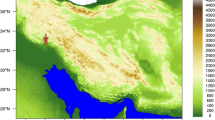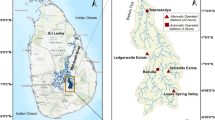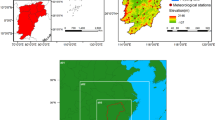Abstract
The frequency of extreme rainfall events in India has increased substantially during the recent decades, causing increased risk of inland flooding. This study investigated the impact and role of four different cumulus parameterization schemes (CPSs) in simulating heavy rainfall events (HRE) over Tamil Nadu State that occurred on 01 December 2015 with five different time step sizes (TSSs) using the Weather Research and Forecasting (WRF) model. Numerical simulations were carried out using a 3-km horizontal grid resolution with relevant forcing parameters from NCEP Global Forecasting System (GFS) datasets. The rainfall data were obtained from the Chennai Doppler Weather Radar station and two automated weather stations (AWS) located at the National Centre for Sustainable Coastal Management (NCSCM 13.01° N, 80.23° E) and Madhavaram AWS (13.2° N, 80.2° E), respectively. The results indicate that simulated HRE using the WRF model is more sensitive to the choice of CPS at different TSS. It is seen that with an increase in TSS, the Kain–Fritsch (KF) scheme over-predicts HRE, while the Grell–Freitas (GF) convection scheme provides reasonably better prediction at 20 s TSS. The results clearly demonstrate that TSS is more sensitive to HRE forecasts in the WRF model, and the corresponding probability of detection (POD), critical success index (CSI) and bias varied from 0 to 81% as TSS increased from 6.67 to 20 s. Also, this study clearly reveals that TSS is very sensitive to the model CPSs in HRE forecasting. Variations attributed to TSS and CPS are reflected not only in rainfall magnitude but also in terms of rainfall location pattern, and depend on changes in simulated distribution of hydrometers, rate of latent heat, vertical velocity and wind flow patterns. Statistical analysis was also carried out to verify model-computed HRE forecasts against the data from two automatic weather stations (AWS). This study indicates that the correlation coefficient (CC) was very good, while the root mean square error (RMSE) was smaller for simulations that used high TSS with simplified Arakawa–Schubert (SAS) and GF CPSs. Numerical simulations that employed KF with high TSS showed a higher intensity in the rainfall forecast.














Similar content being viewed by others
References
Ali, H., & Mishra, V. (2018). Increase in sub-daily precipitation extremes in India under 1.5 and 2.0 C warming worlds. Geophysical Research Letters, 45(14), 6972–6982.
Barrett, A. I., Hogan, R. J., & Forbes, R. M. (2017). Why are mixed-phase altocumulus clouds poorly predicted by large-scale models? Part I: Poorly represented physical processes. Journal of Geophysical Research: Atmospheres, 122, 9903–9926. https://doi.org/10.1002/2016JD026321
Boyle, J., & Klein, S. A. (2010). Impact of horizontal resolution on climate model forecasts of tropical precipitation and diabatic heating for the TWP-ICE period. Journal of Geophysical Research: Atmospheres. https://doi.org/10.1029/2010JD014262
Chai, T., & Draxler, R. R. (2014). Root mean square error (RMSE) or mean absolute error (MAE)?-Arguments against avoiding RMSE in the literature. Geoscientific Model Development, 7(3), 1247–1250.
Chemel, C., Russo, M. R., Hosking, J. S., Telford, P. J., & Pyle, J. A. (2015). Sensitivity of tropical deep convection in global models: Effects of horizontal resolution, surface constraints, and 3D atmospheric nudging. Atmospheric Science Letters, 16(2), 148–154. https://doi.org/10.1002/asl2.540
Das, S., Mitra, A. K., Iyengar, G. R., & Singh, J. (2002). Skill of medium-range forecasts over the Indian monsoon region using different parameterizations of deep convection. Weather and Forecasting, 17(6), 1194–1210.
Dodla, V. B. R., Ratna, S. B., & Desamsetti, S. (2013). An assessment of cumulus parameterization schemes in the short-range prediction of rainfall during the onset phase of the Indian Southwest Monsoon using MM5 Model. Atmospheric Research, 120, 249–267.
Dottori, F., Szewczyk, W., Ciscar, J. C., Zhao, F., Alfieri, L., Hirabayashi, Y., Bianchi, A., Mongelli, I., Frieler, K., Betts, R. A., & Feyen, L. (2018). Increased human and economic losses from river flooding with anthropogenic warming. Nature Climate Change, 8(9), 781–786.
Dube, A., Ashrit, R., Ashish, A., Sharma, K., Iyengar, G. R., Rajagopal, E. N., & Basu, S. (2014). Forecasting the heavy rainfall during Himalayan flooding—June 2013. Weather and Climate Extremes, 4, 22–34.
Dudhia, J. (1989). Numerical study of convection observed during the winter monsoon experiment using a mesoscale two-dimensional model. Journal of the Atmospheric Sciences, 46(20), 3077–3107.
Gopalakrishnan, S. G., Marks, F., Jr., Zhang, X., Bao, J. W., Yeh, K. S., & Atlas, R. (2011). The experimental HWRF system: A study on the influence of horizontal resolution on the structure and intensity changes in tropical cyclones using an idealized framework. Monthly Weather Review, 139(6), 1762–1784.
Grell, G. A., & Freitas, S. R. (2014). A scale and aerosol aware stochastic convective parameterization for weather and air quality modeling. Atmospheric Chemistry and Physics, 14(10), 5233–5250.
Halder, M., Hazra, A., Mukhopadhyay, P., & Singh, D. (2015). Effect of the better representation of the cloud ice-nucleation in WRF microphysics schemes: A case study of a severe storm in India. Atmospheric Research, 154, 155–174.
Han, J. Y., Hong, S. Y., Sunny Lim, K. S., & Han, J. (2016). Sensitivity of a cumulus parameterization scheme to precipitation production representation and its impact on a heavy rain event over Korea. Monthly Weather Review, 144(6), 2125–2135.
Han, J., & Pan, H. L. (2011). Revision of convection and vertical diffusion schemes in the NCEP Global Forecast System. Weather and Forecasting, 26(4), 520–533.
Hasan, M. A., & Islam, A. S. (2018). Evaluation of microphysics and cumulus schemes of WRF for forecasting of heavy monsoon rainfall over the South-eastern Hilly Region of Bangladesh. Pure and Applied Geophysics, 175(12), 4537–4566.
Hong, S. Y., Noh, Y., & Dudhia, J. (2006). A new vertical diffusion package with an explicit treatment of entrainment processes. Monthly Weather Review, 134(9), 2318–2341.
Hunt, K. M., & Menon, A. (2020). The 2018 Kerala floods: A climate change perspective. Climate Dynamics, 54(3), 2433–2446.
Janjić, Z. I. (1994). The step-mountain eta coordinate model: Further developments of the convection, viscous sublayer, and turbulence closure schemes. Monthly Weather Review, 122(5), 927–945.
Jeworrek, J., West, G., & Stull, R. (2019). Evaluation of cumulus and microphysics parameterizations in WRF across the convective gray zone. Weather and Forecasting, 34(4), 1097–1115.
Kain, J. S. (2004). The Kain-Fritsch convective parameterization: An update. Journal of Applied Meteorology, 43(1), 170–181.
Kamaljit, R., Kannan, B. A. M., Stella, S., Sen, B., Sharma, P., Thampi, S. B. (2016). Heavy rains over Chennai and surrounding areas as captured by Doppler weather radar during Northeast Monsoon 2015: a case study. In: Remote Sensing of the Atmosphere, Clouds, and Precipitation VI: 98762G, SPIE Asia-Pacific Remote Sensing, New Delhi, India. https://doi.org/10.1117/12.2239563.
Kendon, E. J., Roberts, N. M., Senior, C. A., & Roberts, M. J. (2012). Realism of rainfall in a very high-resolution regional climate model. Journal of Climate, 25(17), 5791–5806.
Kumar, A., Dudhia, J., Rotunno, R., Niyogi, D., & Mohanty, U. C. (2008). Analysis of the 26 July 2005 heavy rain event over Mumbai, India using the Weather Research and Forecasting (WRF) model. Quarterly Journal of the Royal Meteorological Society, 134(636), 1897–1910.
Li, F., Collins, W. D., Wehner, M. F., Williamson, D. L., Olson, J. G., & Algieri, C. (2011). Impact of horizontal resolution on simulation of precipitation extremes in an aqua-planet version of Community Atmospheric Model (CAM3). Tellus a: Dynamic Meteorology and Oceanography, 63(5), 884–892.
Li, L., Li, W., & Jin, J. (2014). Improvements in WRF simulation skills of southeastern United States summer rainfall: Physical parameterization and horizontal resolution. Climate Dynamics, 43(7–8), 2077–2091.
Liu, J., Bray, M., & Han, D. (2013). A study on WRF radar data assimilation for hydrological rainfall prediction. Hydrology and Earth System Sciences, 17(8), 3095–3110. https://doi.org/10.5194/hess-17-3095-2013
Liu, H., Zhang, D. L., & Wang, B. (2010). Impact of horizontal resolution on the regional climate simulations of the summer 1998 extreme rainfall along the Yangtze River Basin. Journal of Geophysical Research: Atmospheres. https://doi.org/10.1029/2009JD012746
Madala, S., Satyanarayana, A. N. V., & Rao, T. N. (2014). Performance evaluation of PBL and cumulus parameterization schemes of WRF ARW model in simulating severe thunderstorm events over Gadanki MST radar facility—case study. Atmospheric Research, 139, 1–17.
Mishra, S. K., & Sahany, S. (2011). Effects of time step size on the simulation of tropical climate in NCAR-CAM3. Climate Dynamics, 37(3–4), 689–704.
Mishra, V., Aaadhar, S., Shah, H., Kumar, R., Pattanaik, D. R., & Tiwari, A. D. (2018). The Kerala flood of 2018: Combined impact of extreme rainfall and reservoir storage. Hydrology and Earth System Sciences Discussions. https://doi.org/10.5194/hess-2018-480
Mishra, S. K., Srinivasan, J., & Nanjundiah, R. S. (2008). The impact of the time step on the intensity of ITCZ in an aquaplanet GCM. Monthly Weather Review, 136(11), 4077–4091.
Mlawer, E. J., Taubman, S. J., Brown, P. D., Iacono, M. J., & Clough, S. A. (1997). Radiative transfer for inhomogeneous atmospheres: RRTM, a validated correlated-k model for the longwave. Journal of Geophysical Research: Atmospheres, 102(D14), 16663–16682.
Mohan, P. R., Srinivas, C. V., Yesubabu, V., Baskaran, R., & Venkatraman, B. (2018). Simulation of a heavy rainfall event over Chennai in Southeast India using WRF: Sensitivity to microphysics parameterization. Atmospheric Research, 210, 83–99.
Pan, H. L., & Wu, W. S. (1995). Implementing a mass flux convection parameterization package for the NMC medium-range forecast model (p. 43). Office Note 409, National Meteorological Center, National Oceanic and Atmospheric Administration.
Poirier, E., Thériault, J. M., & Leriche, M. (2019). Role of sublimation and riming in the precipitation distribution in the Kananaskis Valley, Alberta. Canada. Hydrology & Earth System Sciences, 23(10), 4097–4111. https://doi.org/10.5194/hess-23-4097-2019
Potvin, C. K., & Flora, M. L. (2015). Sensitivity of idealized supercell simulations to horizontal grid spacing: Implications for Warn-on-Forecast. Monthly Weather Review, 143(8), 2998–3024.
Rajeevan, M., Bhate, J., & Jaswal, A. K. (2008). Analysis of variability and trends of extreme rainfall events over India using 104 years of gridded daily rainfall data. Geophysical Research Letters. https://doi.org/10.1029/2008GL035143
Segele, Z. T., Leslie, L. M., & Lamb, P. J. (2009). Evaluation and adaptation of a regional climate model for the Horn of Africa: Rainfall climatology and interannual variability. International Journal of Climatology, 29(1), 47–65.
Singh, K. S., & Bhaskaran, P. K. (2017). Impact of PBL and convection parameterization schemes for prediction of severe land-falling Bay of Bengal cyclones using WRF-ARW model. Journal of Atmospheric and Solar-Terrestrial Physics, 165, 10–24.
Singh, K. S., Bonthu, S., Purvaja, R., Robin, R. S., Kannan, B. A. M., & Ramesh, R. (2018). Prediction of heavy rainfall over Chennai Metropolitan City, Tamil Nadu, India: Impact of microphysical parameterization schemes. Atmospheric Research, 202, 219–234.
Skamarock, W. C., Klemp, J. B., Dudhia, J., Gill, D. O., Barker, D., Duda, M. G., et al. (2008). A description of the Advanced Research WRF version 3. NCAR Tech. Note NCAR/TN-475+STR, 113 pp. www.mmm.ucar.edu/wrf/users/docs/arw_v3_bw.pdf. Accessed 15 Feb 2021.
Skamarock, J., Klemp, B., Dudhia, J., Gill, D. O., Barker, D. M., Wang, W., Powers, J. G. (2005). A description of the Advanced Research WRF version 2. Tech. Rep. NCAR/TN-4681STR, pp. 88.
Srinivas, C. V., Yesubabu, V., Prasad, D. H., Prasad, K. H., Greeshma, M. M., Baskaran, R., & Venkatraman, B. (2018). Simulation of an extreme heavy rainfall event over Chennai, India using WRF: Sensitivity to grid resolution and boundary layer physics. Atmospheric Research, 210, 66–82.
Srivastava, K., Bhowmik, S. R., & Hatwar, H. R. (2009). Evaluation of different Convective schemes on simulation of thunderstorm event over Delhi by ARPS Model. Mausam, 60(2), 123–136.
Stein, T. H. M., Hogan, R. J., Clark, P. A., Halliwell, C. E., Hanley, K. E., Lean, H. W., et al. (2015). The DYMECS Project: A statistical approach for the evaluation of convective storms in high-resolution NWP models. Bulletin of the American Meteorological Society, 96, 939–951. https://doi.org/10.1175/BAMS-D-13-00279.1
Tao, W. K., Simpson, J., & McCumber, M. (1989). An ice-water saturation adjustment. Monthly Weather Review, 117(1), 231–235.
Taraphdar, S., Pauluis, O. M., Xue, L., Liu, C., Rasmussen, R., Ajayamohan, R. S., Tessendorf, S., Jing, X., Chen, S., & Grabowski, W. W. (2021). WRF gray zone simulations of precipitation over the Middle-East and the UAE: Impacts of physical parameterizations and resolution. Journal of Geophysical Research: Atmospheres, 126, e2021JD034648.
Tian, J., Liu, J., Wang, J., Li, C., Yu, F., & Chu, Z. (2017). A spatio-temporal evaluation of the WRF physical parameterisations for numerical rainfall simulation in semi-humid and semi-arid catchments of Northern China. Atmospheric Research, 191, 141–155.
Vaidya, S. S., & Singh, S. S. (2000). Applying the Betts–Miller–Janjic scheme of convection in prediction of the Indian monsoon. Weather and Forecasting, 15(3), 349–356.
Viswanadhapalli, Y., Srinivas, C. V., Basha, G., Dasari, H. P., Langodan, S., Venkat Ratnam, M., & Hoteit, I. (2019). A diagnostic study of extreme precipitation over Kerala during August 2018. Atmospheric Science Letters, 20(12), e941.
Williamson, D. L. (2013). The effect of time steps and time-scales on parametrization suites. Quarterly Journal of the Royal Meteorological Society, 139(671), 548–560.
Williamson, D. L., & Olson, J. G. (2003). Dependence of aqua-planet simulations on time step. Quarterly Journal of the Royal Meteorological Society, 129, 2049–2064.
Xie, Y., Xing, J., Shi, J., Dou, Y., & Lei, Y. (2016). Impacts of radiance data assimilation on the Beijing 7.21 heavy rainfall. Atmospheric Research, 169, 318–330.
Xu, M., Bao, J. W., Warner, T. T., & Stensrud, D. J. (2001). Effect of time step size in MM5 simulations of a mesoscale convective system. Monthly Weather Review, 129(3), 502–516.
Zittis, G., Bruggeman, A., Camera, C., Hadjinicolaou, P., & Lelieveld, J. (2017). The added value of convection permitting simulations of extreme precipitation events over the eastern Mediterranean. Atmospheric Research, 191, 20–33.
Acknowledgements
The authors would like to acknowledge Dr. B.A.M. Kannan, Regional Meteorological Centre (RMC), Chennai, for providing the reflectivity and rainfall data. Thanks to NCEP and NCAR for providing the analysis and forecast datasets and the atmospheric WRF modelling system that is freely available. We are thankful to NCSCM scientist Dr. R. Muruganandam for their help in the mapping of model domain. Kuvar Satya Singh acknowledges the Department of Science and Technology—Science and Engineering Research Board (DST-SERB), Government of India, for funding the research project File Sanction No. ECR/2018/001185.
Author information
Authors and Affiliations
Corresponding author
Additional information
Publisher's Note
Springer Nature remains neutral with regard to jurisdictional claims in published maps and institutional affiliations.
Rights and permissions
About this article
Cite this article
Singh, K.S., Bonthu, S., Bhaskaran, P.K. et al. Impact of Time Step Size on Different Cumulus Parameterization Schemes in the Numerical Simulation of a Heavy Rainfall Event Over Tamil Nadu, India. Pure Appl. Geophys. 179, 399–423 (2022). https://doi.org/10.1007/s00024-021-02896-8
Received:
Revised:
Accepted:
Published:
Issue Date:
DOI: https://doi.org/10.1007/s00024-021-02896-8




